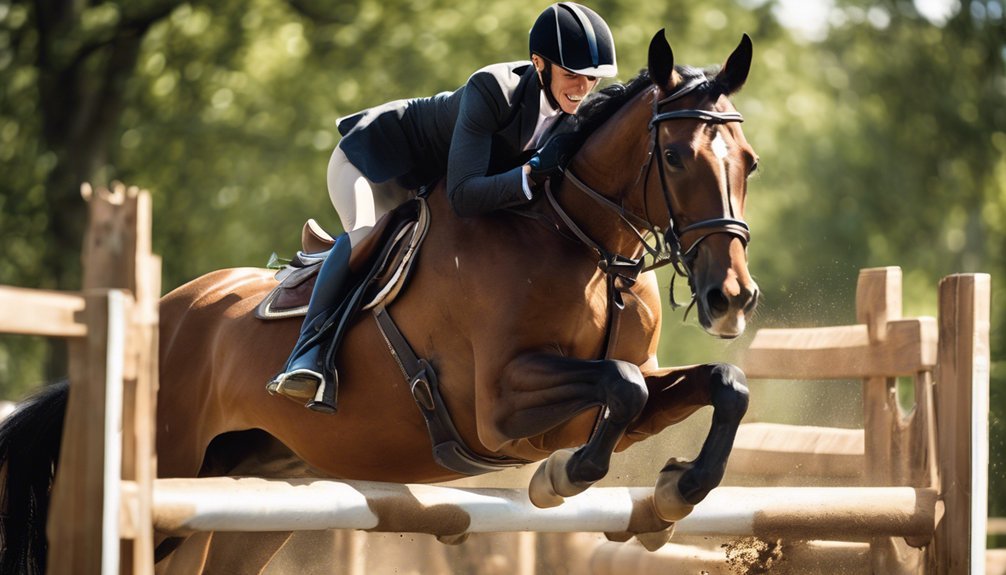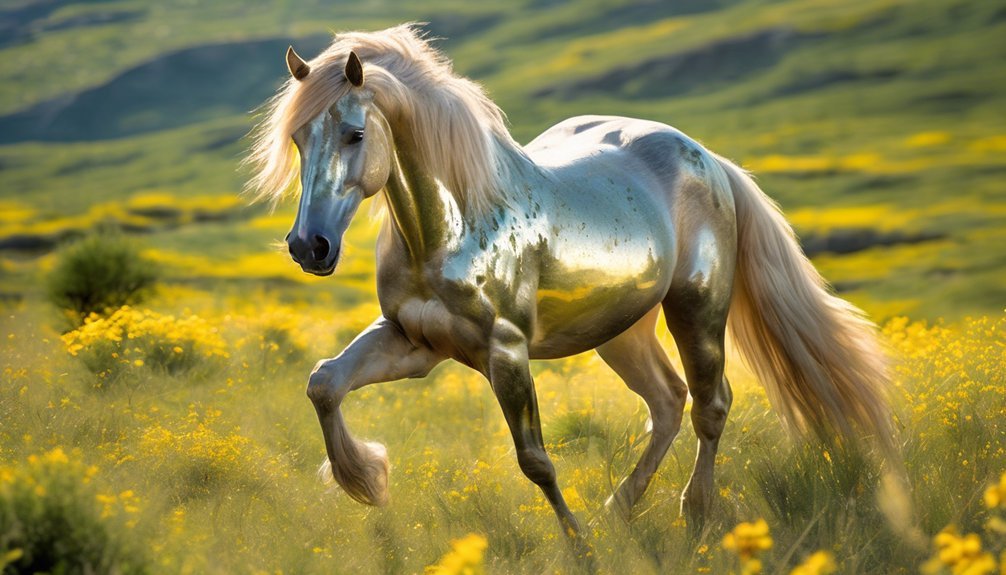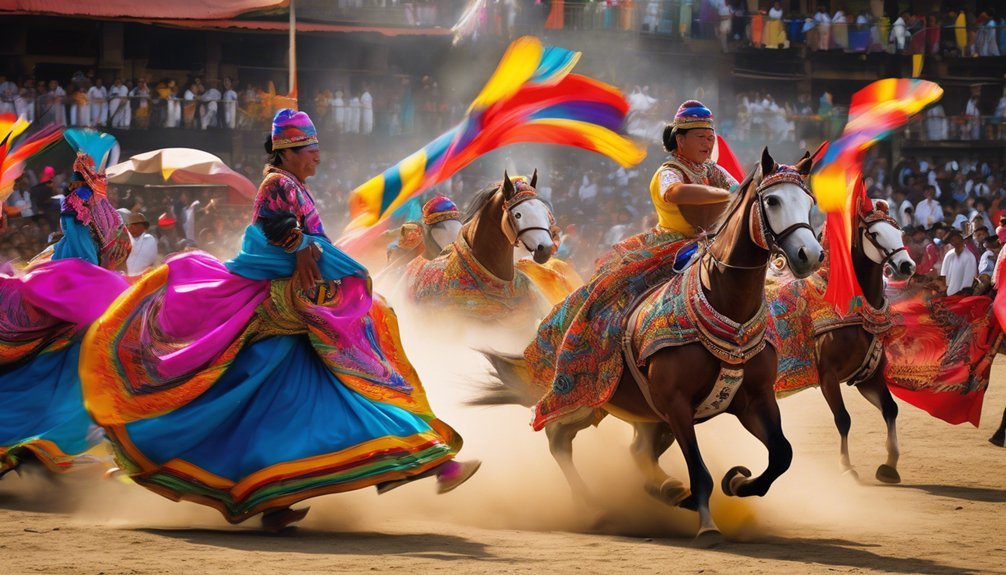
Training a horse for competitive sports requires a clear understanding of your horse's unique personality and needs. You'll want to establish trust and effective communication right from the start. By choosing the right techniques and developing a tailored exercise regimen, you can prepare your horse for the demands of competition. It's essential to monitor nutrition and health closely. Let's explore how you can set realistic goals and incorporate groundwork to enhance your training approach.
Key Takeaways
- Build trust through groundwork and grooming, fostering a strong bond to enhance training effectiveness and performance.
- Assess your horse's fitness level and create a tailored exercise regimen to improve balance, rhythm, and overall performance.
- Incorporate natural horsemanship techniques and positive reinforcement to encourage voluntary participation and positive associations with training.
- Monitor nutrition closely, ensuring the horse receives essential vitamins and minerals for peak performance, while consulting with a veterinarian regularly.
- Implement a pre-ride checklist and structured warm-up routine, including stretching and relaxation techniques to prepare the horse mentally and physically for competition.
Understanding Your Horse's Personality

Understanding your horse's personality is crucial for effective training in competitive sports. Every horse has a unique temperament, influencing how they respond to various training methods.
Pay attention to their behavioral cues—do they shy away from new experiences or eagerly approach challenges? Recognizing these signs helps you tailor your training approach.
For instance, a calm and steady horse may require gentle encouragement, while a more spirited horse could benefit from structured routines to channel their energy. By observing your horse's reactions, you can foster a deeper connection, making training a more positive experience.
Establishing Trust and Communication
To successfully train a horse for competitive sports, establishing trust and communication is essential. Building a strong bond with your horse not only enhances performance but also deepens your relationship.
Here are three effective ways to foster trust and communication:
- Engage in Trust Exercises: Spend time together without pressure. Simple activities like grooming or ground work can help your horse feel secure.
- Use Consistent Communication Cues: Be clear and consistent with your cues, both verbal and physical. This helps your horse understand your expectations.
- Practice Patience and Understanding: Always be patient. Recognize your horse's emotions and respond appropriately to build a supportive environment.
Choosing the Right Training Techniques
When choosing training techniques for your horse, consider both Natural Horsemanship methods and Classical Dressage techniques.
Each approach offers unique benefits and can enhance your horse's performance in competitive sports.
Natural Horsemanship Methods
Natural horsemanship emphasizes building a trusting partnership between you and your horse, which can significantly enhance your training experience.
By focusing on communication through body language, you create a deeper bond that fosters cooperation and understanding.
Here are three key techniques to consider:
- Join-Up: Use your horse's natural instincts to encourage them to approach you willingly, establishing trust from the start.
- Playful Groundwork: Engage in exercises that promote responsiveness and flexibility, reinforcing your connection.
- Positive Reinforcement: Reward desired behaviors with praise or treats, which helps your horse associate training with positive experiences.
Classical Dressage Techniques
Understanding classical dressage techniques can elevate your horse's performance in competitive sports. By focusing on classical movements, you'll develop your horse's strength, flexibility, and responsiveness.
Start with foundational exercises that reinforce balance and rhythm, using training aids like side reins or lunge lines to encourage proper posture. These tools can help your horse understand the nuances of each movement without feeling overwhelmed.
As you progress, incorporate more complex maneuvers such as the piaffe or passage, ensuring your horse remains relaxed and confident.
Remember, patience is key; celebrate small victories along the way. You're building a partnership based on trust and understanding, which is essential for success in dressage competitions.
Stay committed, and your hard work will shine through in the arena!
Developing a Tailored Exercise Regimen
To develop an effective exercise regimen for your horse, start by assessing their current fitness level.
From there, you'll want to gradually increase the intensity of their workouts while incorporating a variety of training activities to keep things engaging.
This thoughtful approach will help enhance your horse's performance and overall well-being.
Assessing Horse's Current Fitness
Before diving into a tailored exercise regimen, it's crucial to assess your horse's current fitness level.
Conducting thorough fitness assessments helps you understand where your horse stands in terms of physical conditioning.
Here are three key areas to evaluate:
- Cardiovascular Health: Check your horse's heart rate after exercise to gauge endurance.
- Muscle Tone: Observe muscle development and symmetry to identify strengths and weaknesses.
- Flexibility and Range of Motion: Assess how freely your horse moves, which can indicate overall fitness.
Gradual Intensity Progression
As you begin developing a tailored exercise regimen for your horse, it's essential to implement a gradual intensity progression to ensure a safe and effective training process.
Start by creating a training schedule that outlines specific goals and timelines. Begin with low-intensity activities, allowing your horse to adapt comfortably.
As your horse builds endurance and strength, gradually increase the intensity increments. This method reduces the risk of injury and helps your horse develop confidence.
Monitor their response closely; adjust the training schedule as needed to maintain a steady progress. Remember, patience is key.
Celebrate small victories along the way, and soon you'll see significant improvements in your horse's performance and overall fitness.
Incorporating Varied Training Activities
Incorporating varied training activities is crucial for keeping your horse engaged and motivated throughout their training regimen.
A tailored exercise plan not only enhances your horse's skills but also builds a stronger bond between you two.
Here are three effective activities to consider:
- Obstacle Courses: Set up diverse challenges that encourage problem-solving and agility.
- Varied Terrain: Incorporate hills, trails, and soft ground to develop strength and adaptability.
- Groundwork Exercises: Focus on communication and trust through lunging and liberty work.
Setting Realistic Goals and Milestones

Setting realistic goals and milestones is crucial for both you and your horse as you embark on the journey of competitive sports. Start by engaging in goal setting that aligns with your horse's current abilities and your aspirations.
Break down larger goals into manageable milestones to keep motivation high. For instance, if you aim to compete at a specific level, set smaller targets like mastering certain skills or improving your horse's fitness.
Milestone tracking can help you monitor progress and celebrate achievements, reinforcing your bond. Remember, patience is key; it's about enjoying the journey together.
Regularly reassess your goals based on your experiences and your horse's development, and don't hesitate to adjust as needed to stay on the right path.
Incorporating Groundwork Into Training
While groundwork might seem like a basic aspect of training, it plays a crucial role in preparing your horse for competitive sports. Incorporating groundwork exercises into your routine helps you build a strong foundation and fosters trust between you and your horse.
Here are three key exercises to get you started:
- Lunging: This exercise enhances your horse's responsiveness and improves their focus while allowing you to observe their behavior.
- Ground Driving: It teaches your horse to follow cues and develop balance, crucial for competitive performance.
- Desensitization: Exposing your horse to various stimuli helps them remain calm and confident in stressful environments.
Monitoring Nutrition and Health
To succeed in competitive sports, you must keep a close eye on your horse's nutrition and overall health.
Start by providing a balanced diet tailored to your horse's age, weight, and activity level. Consider using nutritional supplements to fill any gaps in their diet, ensuring they get the vitamins and minerals crucial for peak performance.
Regular health monitoring is key; check their weight, coat condition, and energy levels frequently. A healthy horse is a happy horse, so don't hesitate to consult with your veterinarian about any concerns.
Preparing for Competition Day

With your horse's nutrition and health in top shape, it's time to focus on preparing for competition day. A well-structured competition routine is essential for success.
Follow this pre-ride checklist to ensure everything's in order:
- Tack Inspection: Check your gear for any signs of wear. A well-fitted saddle and bridle can make all the difference.
- Warm-Up: Allow ample time for a proper warm-up. This helps your horse feel relaxed and ready to perform.
- Mental Preparation: Spend a few moments with your horse to build a connection. Calmness and confidence will enhance your performance.
Frequently Asked Questions
How Long Does It Typically Take to Train a Horse for Competition?
Training timelines vary, but you can expect it to take several months to a couple of years for your horse to achieve competition readiness. Stay patient and consistent, and you'll build a strong partnership together.
What Common Mistakes Should I Avoid During Training?
Avoid common mistakes by ensuring training consistency and clear rider communication. Embrace patience; it builds trust. Remember, your horse thrives on your guidance. Stay positive, and keep your sessions focused to foster a strong bond.
How Can I Assess My Horse's Emotional Readiness for Competition?
To assess your horse's emotional readiness, observe its emotional signals closely. Check for signs of stress and practice effective stress management techniques. Trust your instincts; a calm horse often indicates a solid emotional foundation for competition.
Are There Specific Breeds Better Suited for Competitive Sports?
When considering breeds comparison, note that some horses excel in specific competitive sports due to their athletic capabilities. Thoroughbreds, Warmbloods, and Quarter Horses often stand out, so explore these breeds for optimal performance and partnership.
What Equipment Is Essential for Training and Competing Effectively?
Picture yourself in a sunlit arena, your horse gleaming. For effective training, you'll need quality saddle types and reliable training aids. These essentials ensure both comfort and focus, paving the way for success in competition.
Conclusion
As you embark on this journey with your horse, remember that each step you take shapes your partnership and performance. Keep nurturing that trust and communication, and watch your horse flourish. With dedication, the right techniques, and a keen eye on health, you'll be well on your way to achieving your competitive dreams. But what happens when the gates open and the crowd roars? Will you both rise to the challenge? The adventure is just beginning!





